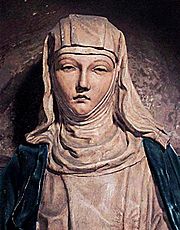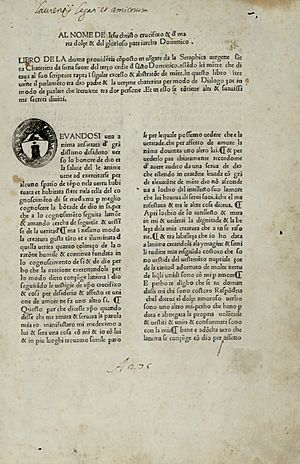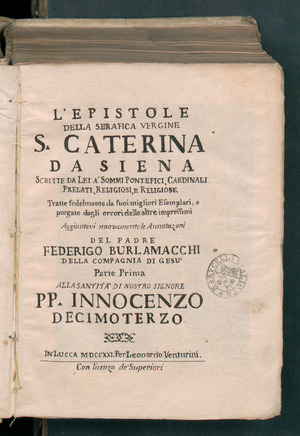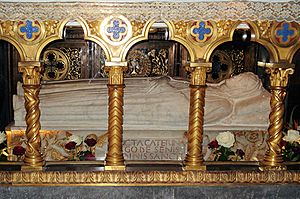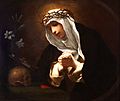Catherine of Siena facts for kids
Quick facts for kids SaintCatherine of Siena TOSD |
|
|---|---|
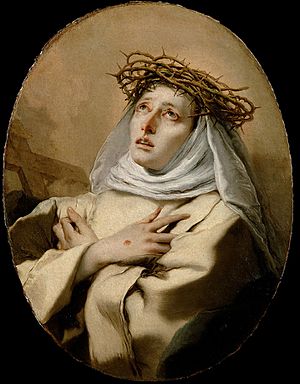
St. Catherine of Siena,
by Giovanni Battista Tiepolo |
|
| Doctor of the Church, Virgin | |
| Born | 25 March 1347 Siena, Republic of Siena |
| Died | 29 April 1380 (aged 33) Rome, Papal States |
| Venerated in | Catholic Church Anglican Communion Lutheranism |
| Beatified | 29 December 1460 |
| Canonized | 29 June 1461 by Pope Pius II |
| Major shrine | Santa Maria sopra Minerva, Rome and the Sanctuary of Saint Catherine, Siena |
| Feast | 29 April; 30 April (Roman Calendar, 1628–1969); 4 October (in Italy) |
| Attributes | habit of a Dominican tertiary, ring, lily, cherubim, crown of thorns, stigmata, crucifix, book, heart, skull, dove, rose, miniature church, miniature ship bearing Papal coat of arms |
| Patronage | against fire; bodily ills; people ridiculed for their piety; nurses; sick people; miscarriages; Europe; Italy; Diocese of Allentown, Pennsylvania, USA; Bambang, Nueva Vizcaya, Philippines; Samal, Bataan, Philippines |
Catherine of Siena (born March 25, 1347 – died April 29, 1380) was an Italian woman who became a very important figure in the Catholic Church. She was a mystic, meaning she had deep spiritual experiences with God. She was also an activist who worked to help others and an author who wrote many important texts.
Catherine had a big impact on Italian literature and the Catholic Church. She was made a saint in 1461. Later, she was named a "Doctor of the Church," a special title given to saints known for their important teachings.
Born and raised in Siena, Italy, Catherine wanted to dedicate her life to God from a young age. This was against her parents' wishes. She joined a group called the "Mantellates," who were pious women, mostly widows, who followed the spiritual path of the Dominican Order.
Catherine became very influential. She played a key role in convincing Pope Gregory XI to move the Pope's home back to Rome from Avignon, France, in 1376. The Pope then asked Catherine to help make peace with the city of Florence. After Pope Gregory XI died, Catherine returned to Siena. There, she dictated her famous spiritual book, The Dialogue of Divine Providence.
When a big split happened in the Church, known as the Western Schism, Catherine went to Rome to support Pope Urban VI. She wrote many letters to leaders and cardinals, urging them to obey Pope Urban VI and protect the Church. Catherine died on April 29, 1380, at age 33, after years of strict fasting. Pope Urban VI led her funeral in Rome.
People quickly began to honor Catherine after her death. Pope Pius II made her a saint in 1461. She was declared a patron saint of Rome in 1866 and of Italy in 1939. In 1970, Pope Paul VI named her the second woman "Doctor of the Church." In 1999, Pope John Paul II also made her a co-patron saint of Europe.
Catherine of Siena is known as one of the most important people in medieval Catholicism. She had a strong influence on the papacy (the Pope's office) and wrote many works. It was very unusual for a woman in the Middle Ages to have such political influence. Her book The Dialogue, hundreds of letters, and many prayers also make her a key figure in Italian literature.
Contents
Catherine's Early Life and Calling
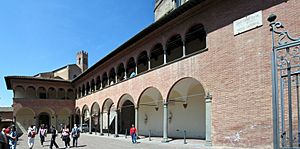
Catherine was born Caterina di Jacopo di Benincasa on March 25, 1347, in Siena, Italy. This was just before the terrible Black Death spread across Europe. Her mother, Lapa Piagenti, was about 40 years old and had already given birth to 22 children. Catherine was a twin, but her sister Giovanna died soon after birth. Catherine's father, Jacopo di Benincasa, was a cloth dyer.
As a child, Catherine was very cheerful. Her family even gave her the nickname "Euphrosyne," which means "joy" in Greek.
A Vision and a Vow
When Catherine was about five or six years old, she had her first special vision. She was walking home with her brother when she saw Jesus sitting in glory with the Apostles Peter, Paul, and John. According to her confessor and biographer, Raymond of Capua, Catherine decided at age seven to give her whole life to God.
Family Challenges and Inner Strength
When Catherine was 16, her older sister Bonaventura died. Soon after, Catherine learned that her parents wanted her to marry Bonaventura's widower. Catherine was strongly against this. She began to fast strictly and even cut off her long hair to protest her parents' wishes.
Catherine found strength by creating an "inner cell" in her mind. She imagined her father as Christ, her mother as the Blessed Virgin Mary, and her brothers as the apostles. Serving them humbly helped her grow spiritually. She chose a life of prayer and service outside a convent, following the example of the Dominicans. Eventually, her father allowed her to live as she wished.
Joining the Mantellates
Catherine had a vision of Saint Dominic, which gave her strength. Her mother, Lapa, was still worried about Catherine's health and took her to the baths. Catherine became very ill, which finally made her mother accept her wish to join the "Mantellates." This group of devout women taught Catherine how to read. She lived a quiet life of prayer and solitude at home.
Catherine often gave away her family's food and clothing without asking. She never asked for anything for herself. She believed she had a table laid for her in Heaven with her true family.
Catherine's Public Life and Influence
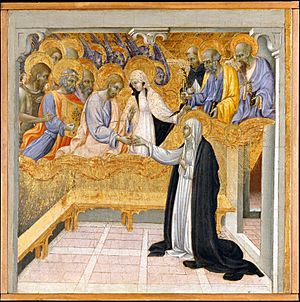
Around 1368, when Catherine was 21, she had a special spiritual experience. She described it as a "Mystical Marriage" with Jesus. After this, Christ told her to leave her quiet life and help others in the world. Catherine returned to her family and began caring for the sick and poor in hospitals and homes. Her good deeds in Siena attracted many followers, both women and men.
Intervening in Politics
As tensions grew in Siena, Catherine felt called to get involved in politics. In 1374, she traveled to Florence. It was around this time that Raymond of Capua became her confessor and spiritual guide.
After this visit, Catherine began traveling with her followers across Italy. She spoke about the need for Church leaders to improve and for people to repent and renew their faith through "total love for God." In 1375, she used her influence to persuade the cities of Pisa and Lucca not to join a group against the Pope. She also encouraged a new crusade. In Pisa, in 1375, she reportedly received the stigmata, which are marks like the wounds of Christ, though only she could see them.
Letters and Papal Return
Catherine also shared her views through letters. From 1375 onward, she dictated letters to scribes. These letters were sent to her followers and to important leaders. She begged for peace between Italian cities and for the Pope to return to Rome from Avignon. She wrote many letters to Pope Gregory XI, asking him to reform the clergy and the Church's administration.
In June 1376, Catherine went to Avignon as an ambassador for Florence to make peace with the Pope. She was not fully successful, but she did try to convince Pope Gregory XI to return to Rome. Gregory did move his administration back to Rome in January 1377. Historians still debate how much Catherine's influence played a part in this decision.
Later Missions and Death
Catherine returned to Siena and founded a women's monastery outside the city. She spent time in Rocca d'Orcia, working to make peace and preach. During this time, in late 1377, she had the experience that led to her writing The Dialogue. She also learned to write herself, though she still used secretaries for most of her letters.
In 1378, Catherine traveled to Florence again to seek peace between Florence and Rome. After Pope Gregory's death, riots broke out in Florence, and Catherine was almost killed. Peace was finally made in July 1378, and Catherine returned to Florence.
In late 1378, when the Western Schism began, the new Pope, Urban VI, called her to Rome. She stayed at the Pope's court, trying to convince nobles and cardinals that he was the rightful Pope.
For many years, Catherine had practiced very strict fasting. She received Holy Eucharist almost every day. Her confessor, Raymond, told her to eat properly, but Catherine said she couldn't, calling it an "illness." From early 1380, she could not eat or drink water. On February 26, she lost the use of her legs.
Catherine died in Rome on April 29, 1380, at the age of 33. She had suffered a stroke eight days earlier that paralyzed her from the waist down. Her last words were, "Father, into Your Hands I commend my soul and my spirit."
Learning About Catherine's Life
We know a lot about Catherine from her own writings. These include nearly 400 letters, her book The Dialogue, and her prayers. They show us her personality, her teachings, and her work.
Much information also comes from writings made shortly after her death. These were written to promote her sainthood. Even though they are very supportive of her, they are still important for historians.
Key Biographies
One important source is the Legenda Major, written by Raymond of Capua. He was Catherine's spiritual director and close friend from 1374 until her death. He finished his Life of Catherine in 1395.
Another important work is Libellus de Supplemento, written by Tommaso d'Antonio Nacci da Siena (also called Thomas of Siena) between 1412 and 1418. This book added more details to Raymond's work, using notes from Catherine's first confessor that are not found anywhere else.
Thomas of Siena also helped gather documents for Catherine's canonization process. These documents included testimonies from almost all of Catherine's followers.
Catherine's Writings
Catherine of Siena's writings fall into three main types:
- The Dialogue of Divine Providence: This is her most important book. She probably started it in October 1377 and finished it by November 1378. Many people at the time said she dictated most of the book. It is written as a conversation between a soul seeking God and God himself.
- Her Letters: Catherine's letters are considered major works of early Tuscan literature. She dictated many of them, though she learned to write in 1377. About 382 of her letters still exist. In her letters to the Pope, she often called him Babbo ("Daddy") instead of a formal title. She also wrote to kings, cardinals, and many religious figures. About one-third of her letters were to women.
- Her Prayers: Twenty-six of Catherine's prayers have survived. Most of these were written in the last 18 months of her life.
Catherine's Beliefs and Teachings
Catherine's beliefs can be described as mystical. She used her deep spiritual experiences to guide her own life and help others. She wanted to achieve a close union with God. Catherine practiced extreme fasting and self-discipline. Eventually, she lived only on the Eucharist (Holy Communion) each day. For Catherine, this practice helped her fully experience her love for Christ. Many of her visions were related to food.
She saw Christ as a "bridge" connecting the soul to God. She shared this idea and other teachings in her book The Dialogue. This book explains her mystical ideas in a very organized way. However, these ideas came more from her spiritual experiences than from pure logic.
In one letter to her confessor, Raymond of Capua, Catherine wrote about a conversation she had with Christ. He told her: "Do you know what you are to Me, and what I am to you, my daughter? I am He who is, you are she who is not." This idea means that God is the source of all existence. She also described God in The Dialogue as a "sea, in which we are the fish." This means that God is the endless being that supports everything.
Honoring Saint Catherine
Catherine was buried in the cemetery of Santa Maria sopra Minerva in Rome. After reports of miracles at her grave, Raymond moved her body inside the Basilica of Santa Maria sopra Minerva, where it remains today.
Her Head in Siena
However, her head was separated from her body and placed in a bronze bust. This bust was taken to Siena and carried in a procession to the Dominican church. Catherine's mother, Lapa, who lived to be 89, walked behind the bust. She had seen her family's wealth and happiness end and had outlived most of her children. She helped Raymond of Capua write her daughter's biography. The well-preserved head and a thumb are still kept in the Basilica of San Domenico in Siena.
Official Recognition
Pope Pius II, who was also from Siena, made Catherine a saint on June 29, 1461.
On October 4, 1970, Pope Paul VI named Catherine a Doctor of the Church. This honor was given to Teresa of Ávila just a few days earlier, making them the first women to receive this title.
Catherine's feast day (a day to celebrate her) was first set on April 29, the day she died. But because another saint's feast day was also on April 29, Catherine's was moved to April 30 in 1628. In 1969, her feast day was moved back to April 29.
Patronage
Catherine of Siena is a special patron saint for many things. On April 13, 1866, Pope Pius IX declared her a co-patroness of Rome. On June 18, 1939, Pope Pius XII named her a joint patron saint of Italy along with Francis of Assisi.
On October 1, 1999, Pope John Paul II made her one of Europe's patron saints. She is also the patroness of a Catholic American women's group called Theta Phi Alpha.
A Posthumous Miracle Story
The people of Siena wanted Catherine's body back. A story tells of a miracle that helped them. Knowing they couldn't sneak her whole body out of Rome, they decided to take only her head in a bag. When Roman guards stopped them, they prayed to Catherine for help. When they opened the bag for the guards to see, it was no longer her head but full of rose petals!
Catherine's Lasting Impact
Catherine is considered one of the most important mystics and spiritual writers in the Catholic Church. She is still highly respected for her spiritual writings and her courage to "speak truth to power." It was very rare for a woman in her time to have such a big influence on politics and world history.
Main Places of Worship
The main churches honoring Catherine of Siena are:
- Santa Maria sopra Minerva in Rome: This is where her body is kept.
- Basilica of San Domenico in Siena: This church holds the well-preserved head of Catherine of Siena.
- Shrine of Saint Catherine in Siena: This is a group of religious buildings built around Catherine's birthplace.
Images for kids
-
Domenico Beccafumi, The Miraculous Communion of St. Catherine of Siena, c. 1513–1515, Getty Center, Los Angeles, California
-
Baldassare Franceschini, Saint Catherine of Siena, 17th century, Dulwich Picture Gallery
-
Giovanni di Paolo, St. Catherine of Siena, c. 1475, tempera and gold on panel. Fogg Art Museum, Cambridge, England.
-
This painting depicts the Virgin giving the rosary to St. Dominic; in the scene also appear Fray Pedro de Santa María Ulloa, Saint Catherine of Siena and Servant of God, Mary of Jesus de León y Delgado. The fresco is located in the Church of Santo Domingo in San Cristóbal de La Laguna, Tenerife, Spain.
See also
 In Spanish: Catalina de Siena para niños
In Spanish: Catalina de Siena para niños


